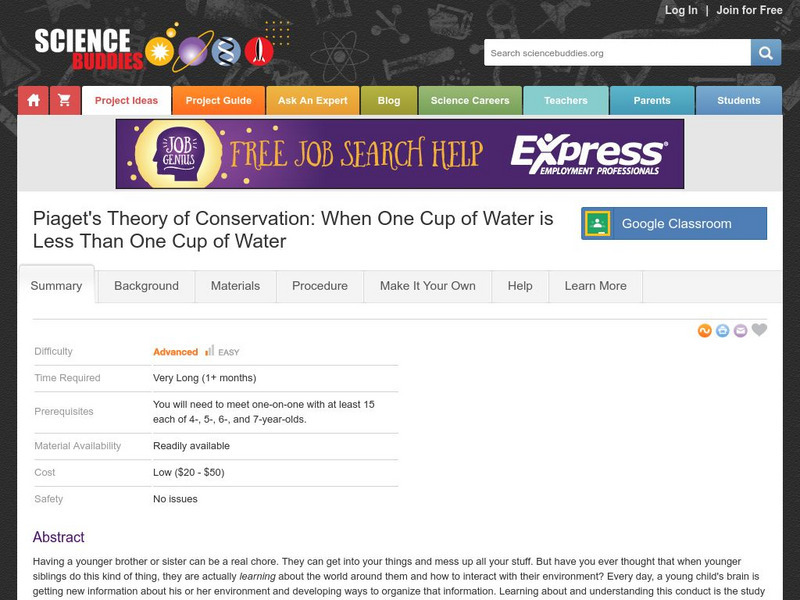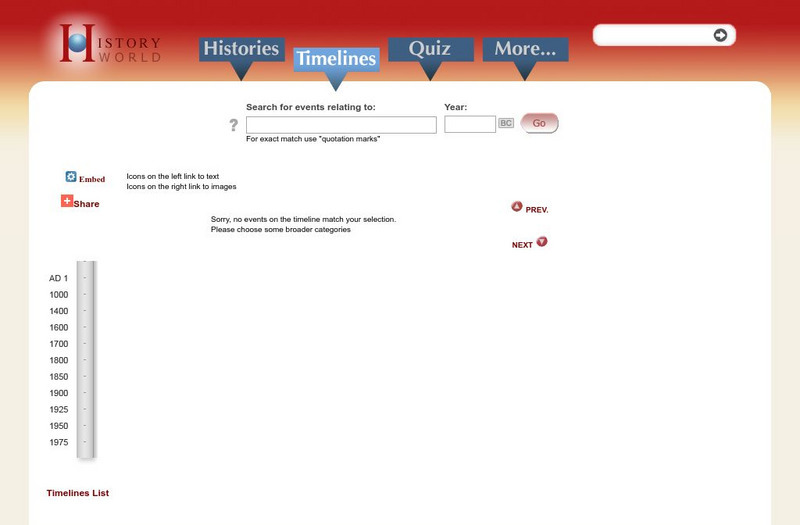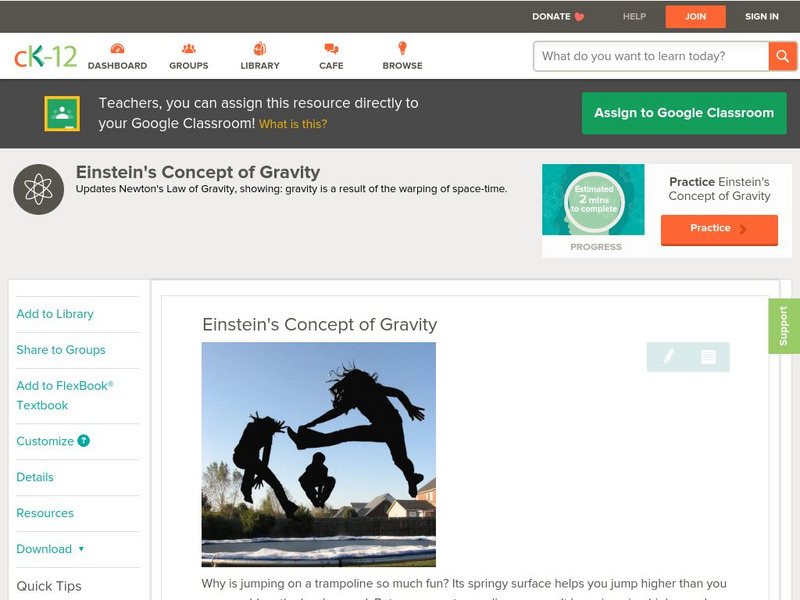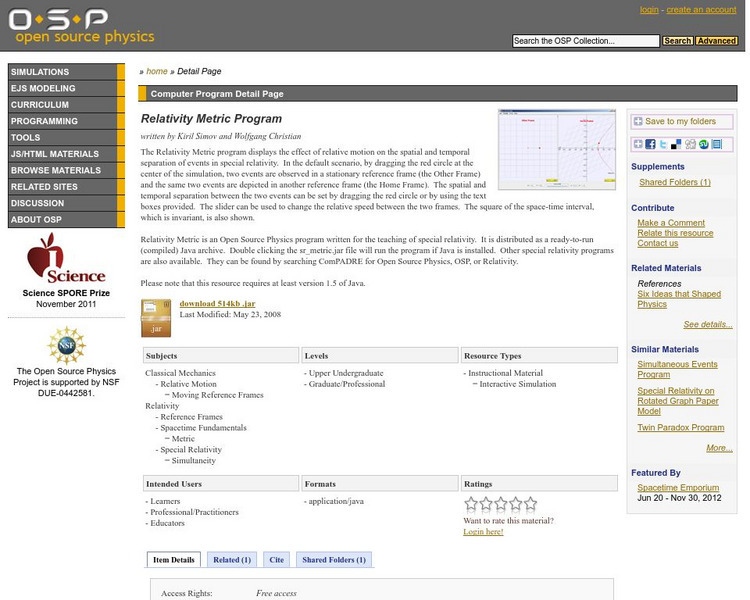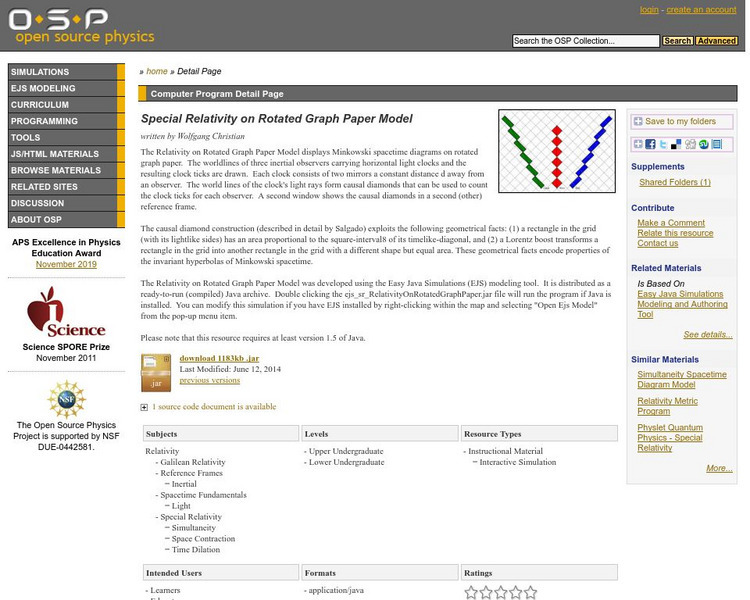Curated OER
Numerical Determination of Drag Coefficients
Young scholars create a video of an object falling with a drag. In this physics instructional activity, students calculate drag coefficient using data from Logger Pro. They calculate velocity and acceleration of the object.
PBS
Pbs: A Science Odyssey
Website for the PBS series "A Science Odyssey." Numerous opportunities to explore the people and discoveries of science.
Ducksters
Ducksters: Physics for Kids: Theory of Relativity Light and Time
Kids learn about the speed of light and time dilation in regards to the theory of relativity in the science of physics. Also how gravity can change the passage of time.
Ducksters
Ducksters: Physics for Kids: Theory of Relativity
Kids learn about the theory of relativity in the science of physics including examples, special vs. general, length contraction, and E=mc2.
Open Curriculum
Open Curriculum: General Relativity
Read this article to help understand and describe Einstein's general theory of relativity.
PBS
Pbs Learning Media: That's My Theory!
Become a game show contestant in this online activity from A Science Odyssey and ask a series of questions to a panel of mystery scientists, using the answers to determine which scientist is Einstein.
Florida State University
Florida State University: Science, Optics & You: Albert Einstein
Biography of Albert Einstein (1879-1955), one of the most famous physicists of the last century, best known for his theory of relativity.
Science Struck
Science Struck: What Is Gravity and How Does It Work
A very detailed look at gravitational force and the many theories that have been put forward to try to explain it. Includes lots of illustrations.
National Science Foundation
National Science Foundation: Astronomy and Space: Research Overview
Explore some of our most fundamental questions about space exploration with this research overview collected by scientists at the National Science Foundation. Additionally, experience deep space first-hand with telescope interactives.
Story Behind the Science
Story Behind the Science: Detection of Black Holes [Pdf]
Article outlining the scientific history behind the discovery of black holes. The writer discusses how scientific theories guide scientists in creating explanations for natural phenomena.
Wolfram Research
Wolfram Science World: Albert Einstein (1879 1955)
This site about Albert Einstein examines many of his theories. It also includes a list of Einstein quotes and references.
Science Buddies
Science Buddies: Piaget's Theory: One Cup of Water Is Less Than One Cup of Water
In this human behavior science fair project, the student will learn about Piaget's developmental stages and the Theory of Conservation. The student will investigate the age at which children understand the equality of numbers and mass....
Vision Learning
Visionlearning: Earth Science: Plate Tectonics I: Geologic Revolution
Instructional module focusing on the development of plate tectonic theory. Discussion includes the evidence of Pangaea, and the processes of seafloor topography and seafloor spreading. Site also includes an interactive practice quiz and...
Georgia Department of Education
Ga Virtual Learning: Special Relativity and Quantum Mechanics
In this interactive tutorial students explore special relativity and quantum mechanics. Learn basic tenets of the theory of special relativity and the relationship between mass and energy. Also discover the evidence for the particle...
Vision Learning
Visionlearning: Plate Tectonics: The Origin of Plate Tectonic Theory
Discover Alfred Wegner's ideas relating to continental drift and seafloor spreading which are both evidence to the concept of plate tectonics.
Science Buddies
Science Buddies: What's the Fastest Way to Cool a Soda?
When you are craving an ice cold drink of soda, the last thing you want is to be stuck with a bunch of soda cans at room temperature. This fun science experiment sends you on a discovery to find the fastest way to cool soda with...
Other
History World: Greek Science Timeline
A timeline of scientific discoveries and theories of the ancient Greeks. It covers the period from 585 BC to 150 AD, with three additional entries for related events in the 1900s. Each entry has links to additional content on the website...
Science Struck
Science Struck: Biography of Albert Einstein
The life and many accomplishments of Albert Einstein are detailed in this article. Includes descriptions of his scientific theories and contributions.
CK-12 Foundation
Ck 12: Physical Science: Einstein's Concept of Gravity
[Free Registration/Login may be required to access all resource tools.] Explores Einstein's theory of gravity and the warping of space-time.
American Association of Physics Teachers
Com Padre Digital Library: Open Source Physics: Relativity Metric Program
Graphical visualization of how the relative motion of two events affects their spatial and temporal separation in special relativity.
Math Science Nucleus
I. Science Ma Te: Integrating Science, Math and Technology
This site offers a wealth of online textbook-related materials that encourage the discovery of science in the world around us. Enter the site to access material on specific topics. Each section contains reading material (complete with...
American Association of Physics Teachers
Com Padre Digital Library: Open Source Physics: Special Relativity on Rotated Graph Paper Model
A representation of Minkowski spacetime diagrams using graph paper that is rotated, showing the world lines of three stationary observers with light clocks.
National High Magnetic Field Laboratory
Magnet Academy: Timeline of Electricity and Magnetism: 1900 1909
Albert Einstein publishes his special theory of relativity and his theory on the quantum nature of light, which he identified as both a particle and a wave. With ever new appliances, electricity begins to transform everyday life.
CK-12 Foundation
Ck 12: Physical Science: Kinetic Theory of Matter
[Free Registration/Login may be required to access all resource tools.] Kinetic theory of matter and how kinetic energy relates to the state of matter.









